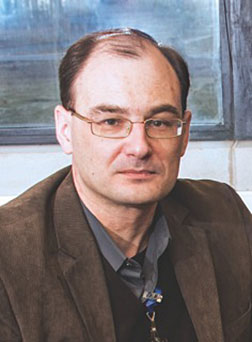- Number 434 |
- March 9, 2015
PPPL’s award winning Ilya Dodin creates robust formulas for analyzing waves in fusion plasmas

PPPL’s award winning Ilya Dodin.
Photo by Elle Starkman/PPPL
It’s fitting that physicist Ilya Dodin of DOE's Princeton Plasma Physics Laboratory (PPPL) was the first to receive the American Physical Society’s Thomas H. Stix Award for Outstanding Early Career Contributions to Plasma Physics Research.
Dodin, honored at the annual APS-Division of Plasma Physics meeting in New Orleans in October, was recognized for his research on waves in plasmas. The award is named for the late Princeton University Professor Thomas H. Stix, a pioneering plasma physicist at PPPL and first director of the Princeton Program in Plasma Physics. Stix, who died in 2001, wrote one of the most influential books about waves in plasmas.
“I was really surprised and honored and I was very happy,” Dodin said after receiving the award at the conference. “I have recently been working with students a lot and this is very inspiring.”
Many types of waves
There are many types of waves in the hot, electrically charged plasma gas that fuels fusion reactions. Dodin’s mathematical formulas for describing these waves could provide the key to learning how to control them.
Dodin, who splits his time between the University and the PPPL Theory Department, uses Stix’s textbook, “The Theory of Plasma Waves,” as a resource in a graduate course he teaches. This course is compulsory for all graduate students in plasma physics, as it was for Dodin, who took the course himself before earning his doctorate from Princeton in 2005.
“I appreciate Ilya being the first recipient of the Thomas Stix award,” said Amitava Bhattacharjee, head of the Theory Department at PPPL. “It’s especially appropriate that he has won the prize in an area of work for which Professor Stix was celebrated.”
From student to valued colleague
A native of Nizhniy Novgorod in central Russia, Dodin graduated from the Advanced School of General and Applied Physics at Nizhniy Novgorod State University, where he earned bachelor’s and master’s degrees. He entered the Princeton Program in Plasma Physics, a division of the University’s Department of Astrophysical Sciences, in 1999.
“He now teaches me more than I teach him,” said Nat Fisch, director of the Program in Plasma Physics, who was Dodin’s thesis adviser and now calls him a valued colleague. “Ilya Dodin has gotten glowing reviews from students taking his class precisely because he brings his own research into the classroom,” Fisch noted. “I think students appreciate when you’re teaching a class and you bring a subject to life and point out not just what people know, but how people use these tools in figuring out what they don’t know.”
Dodin is not only invaluable to PPPL’s physics program and a brilliant researcher, Fisch added. “He also has a nice way about him in approaching problems in physics together with colleagues. He has a gentle way in dealing with people.”
Robust equations
Dodin’s formulas describe the behavior of waves even as the parameters governing them change. “By putting equations in a simplified but robust form, you can see effects that are much harder to see from all-inclusive equations,” Dodin said. “The work that I’ve been doing is about learning how to make the approximations right for the general theory of these waves. We apply it to specific waves too, but the main point at this stage is to get the fundamental theory right.”
Dodin’s research could provide an efficient way to analyze the waves found in fusion experiments such as those done on PPPL’s National Spherical Torus Experiment, which is completing a $94 million upgrade, and ITER, the international fusion facility under construction in France. Such analysis could eventually lead to codes for modeling the control of fusion plasmas. “If the code is more efficient you can experiment with it more and eventually you can predict the behavior of waves better,” Dodin said. “That can also lead to better ways of launching waves in a tokamak.”
The possibility of applying Dodin’s formulas to all kinds of waves has attracted the attention of researchers in fields like quantum mechanics. “Quantum waves behave in a very similar manner to the waves we have in plasma,” said Dodin, “and there may be a lot of potential in bridging the quantum and plasma theories.”
Fisch looks for Dodin’s work to have growing influence as more physicists apply his formulas to their own research. “The greatest part of the impact is yet to come when people will begin to adopt these methods,” Fisch said.
By Jeanne Jackson DeVoe
Submitted by DOE's Princeton Plasma Physics Laboratory
